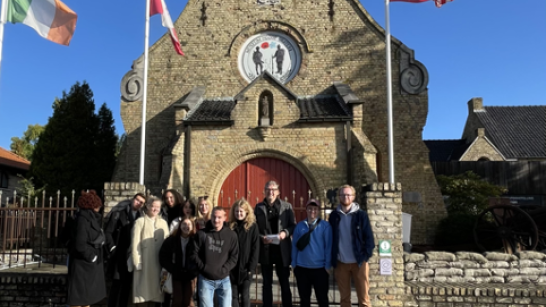
On 1 October, BSoG BA students attending the course “International Relations Between the Wars” (Prof. Dieringer) went on a study trip to the Ypres/Ieper area, also known as the “killing fields of Flanders”. Armistice (11 November) is an important date to remember how imperialism, nationalism, colonialism and great power confrontation culminated in the “Great War”. Below is an account of the study trip, written by our students themselves.
Stop 1: Hooge Crater Museum: The History of World War I in Belgium
Written by Charlotte Mavandalt, Ashleigh Patterson, Grace Ryan, Sofie Skovborg, Wyatt Solarte, Sopo Tarimanishvili, Mattison Wager
The Hooge Crater Museum, maybe the best private museum on WWI in Belgium, is situated in one of the most horrific locations on the Western front. We received a guided tour of the museum placed close to the central battlefields of the Great War in Belgium near Ypres.
The museum is named after the crater created by an explosion during 1915, a point in time at which the most intense battles of WW1 were taking place in this area. The crater no longer exists, but the museum brings the memory of the fighting into the 21st century. The buildings which contain the Hooge Crater Museum were initially created as accommodation for the people working at the Chateau of the deVinck family. After the war the buildings housed a church and a school. In 1994, the buildings were turned into the private museum we experienced in October 2022.
Trench warfare in Belgium
World War 1 in Belgium started as a mobile race to the sea. The French and the German armies were eager to secure access to the ports, but soon the fronts were frozen in place stretching all the way from Switzerland to Western Belgium. The frontline did not move much until 1918 when the stalemate was broken by the American entry into the war.
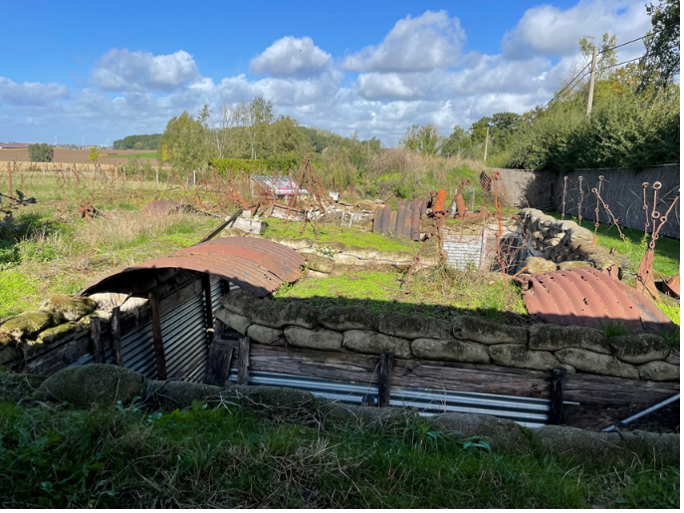
Ieper was an important city along the Western front. There, the Allies formed the Ypres Salient, and fought the German forces continuously from 1914 to 1918 to ensure the Central Powers could not invade further. There were three pivotal events in Ypres during WWI: the First Battle of Ypres (19 Oct - 22 Nov 1914), the Second Battle of Ypres (22 April 1915 - 25 May 1915), and the Third Battle of Ypres (31 July to 10 Nov 1917). While the Second Battle is notable because it was the first time that poison gas was used in warfare, the third battle, known as the battle of Passchendaele, was the largest and most costly in terms of human casualties. By the end of the conflict, both sides had lost nearly half a million soldiers, while only a few miles of ground had been won by the enemies and often lost again within days. Ypres itself was destroyed by bombings throughout the course of the war, leaving the town’s citizens to rebuild the city completely after the war.
Technology of World War I
While the First World War was an unprecedented humanitarian disaster, a vast amount of technology was successfully developed. During the first year of the war, uniforms were adapted to the realities of trench warfare. The colourful uniforms used in the 19th century were abandoned in favour of neutral colours, and helmets were developed to protect rather than decorate the head in the trenches.
In 1915, mustard gas was used for the first time in Western Belgium near Ypres by the German troops, although international agreements against the use of gas were already in place. As the war progressed, more cruel types of gas were developed as well as gas masks. Three different types of shells were used, one being the gas shell, which can still be found throughout the fields of Flanders.
In 1916 yet another murderous machine was deployed, this time by the allied forces, constructed by Renault: the tank. In response, anti-tank artillery was developed by the Germans.
Measures against bad sanitation
In the Hooge Crater Museum, an original ambulance in service during the First World War is among the first exhibits to catch your eye. An intricate system of dressing stations was created to take care of soldiers wounded in battle, and the central principle was to treat the most severely wounded first, and as close to the frontline as possible. From today`s perspective, knowledge of sanitation and medicine was rather limited then. Sterilisation of equipment was still not in place and infections killed many soldiers who could have been saved with proper treatment. The trenches were full of mud, water, rats, lice and flies, so even minor wounds had the potential to become a serious problem. In the hospitals, many women worked as nurses to allow men to fight at the frontline, since women were not allowed to fight themselves.
The impact of WWI on the Ypres area
At the end of the First World War the area around Ypres was utterly destroyed. Missions were deployed to find dead soldiers in the mud and give them a proper burial. Even more than 100 years after the war the remains of around 80 soldiers per year are found in Flanders. Memorials are scattered around the area to commemorate the soldiers who died in battle.
Stop 2: The Tyne Cot Cemetery
Written by Ian Hodis, Matilda Kaari and Mia Jones
During and after the war, thousands of discovered bodies needed to be buried in a dignified manner far away from home. This is how the British dealt with it: The inexistence of an official system for scheduling or documenting burials led to numerous unmarked graves and small temporary cemeteries. To improve the situation, the Commonwealth War Graves Commission (CWGC) was founded. The commission had to contact grieving families from the UK and almost all countries of the British Commonwealth.
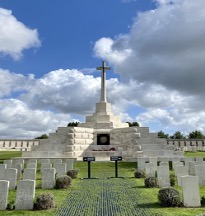 |
The Creation of Tyne Cot Memorial Approximately 35,000 soldiers and officers whose graves are unknown have their names exposed in the Tyne Cot Memorial. On June 20, 1927, Sir Gilbert Dyett unveiled the memorial, designed by Sir Herbert Baker, with sculptures by Joseph Armitage and F.V. Blundstone. Remains from the Passchendaele and Langemarck battlefields and a few smaller burial cemeteries were brought in after the armistice, substantially expanding the initial battlefield cemetery of 343 graves. In terms of interment, Tyne Cot is currently the largest Commonwealth war cemetery in the world. |
|
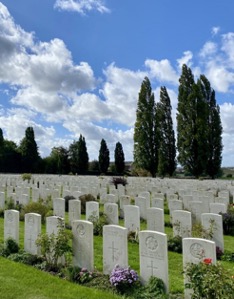 |
The Experience Tyne Cot Cemetery, consisting of the cemetery itself and a museum, is a beautifully designed site. The museum is held in minimalistic style, spacious with big windows bringing calmness to the visitor. The atmosphere inside the museum is peaceful but sad. The walls are painted dark and a calm voice is speaking, reading the names and age of the soldiers buried here. On the cemetery, gravestones and memorials are held in white, producing a feeling of peace and dignity. In the middle of the cemetery there is a high ‘pyramid-style’ memorial with a cross on top accompanied by a half-circle memorial framing the area nicely. |
Personal experience
Mia: Visiting the Tyne Cot Cemetery was an incredible experience. It may be odd to describe a cemetery as beautiful, but it was nothing short of that. I appreciated how they were able to turn the tragedy of the war into something grand that could be remembered forever. Memorialization is a difficult thing to do. Especially when you are trying to memorialize soldiers that could not be clearly identified. However, the museum was able to do a tremendous job at giving these fallen soldiers an identity. I am extremely grateful to have been given the opportunity to witness this site in person.
Matilda: The Tyne Cot Cemetery was an impactful experience for me. The endless view of white gravestones was something that everyone should see. At the same time, I was amazed and saddened by the view as I understood how many soldiers were laying in there knowing it was only a small fraction of all the soldiers killed during the war. Especially noticing that some of the gravestones belonged to extremely young soldiers, was heartbreaking. Seeing the number of gravestones made everything we have learned about WWI and soldiers who died during it, more real and somewhat ‘touchable’.
The cemetery itself was well-kept and beautifully designed. The atmosphere there was peaceful. When walking in the cemetery, you could feel the appreciation and respect towards the buried soldiers there. Overall, I found the visit to the Tyne Cot Cemetery an extremely valuable experience.
Stop 3: Flanders Field Museum
Written by Katy Beasley, Niccolo Benso, Jayani Brooks, Carly Calderone, Alessandra Coccaro, Matilde Dario, Sabena Gaddy
Belgium in The Great War
Behind every struggle for peace is a story, and In Flanders Fields Museum seeks to share these lost narratives. The museum is located in the once critical location of Ypres, in West Flanders, Belgium, where thousands of soldiers tragically lost their lives in the Great War. Allied troops held the Ypres front line, the Salient, through unbelievable hardship. Nearly 600,000 soldiers fell victim to the war here, and In Flanders Fields Museum preserves the facts, so others can remember, reflect, and continue to question the sense of such atrocities.
Ypres Cloth Hall
The museum’s collection is held inside the Ypres Cloth Hall: a grand medieval building that was in ruins by the end of WWI. As the hall was restored in subsequent years, it now symbolizes the strength of the Belgian people and their journey from devastation to recovery.
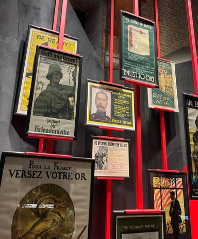
Inside the museum
The museum takes visitors step-by-step through the war, beginning with the German invasion. Walking east to west on the floor map of Belgium, you can see video footage from as early as August 1914. On the walls, propaganda posters from various countries are hung, all rallying for support and aiming to mobilize civilians.
On the 7th of October, 1914, German troops invaded Ypres and, thus, the first battle began. By November, troops were fighting to hold their lines at the invasion of the Yser, a river in West Flanders. Here, the Belgian army fought against the German troops. Later on, help from the French and British armies pushed the Germans to retire – at least temporarily, as two more devastating battles were yet to be fought.
At the end of the first battle of Ypres, the Germans took to the hills so they could see the movement of the troops. Airplanes and Zeppelins were used to capture pictures of movements on the enemy side.
Alternatively, the British troops specialized in digging tunnels; “If you can’t win the war in the field, then you try underground”, as they acclaimed. Soldiers built tunnels in the enemy’s direction and then set mines to explode when the time was right. Sometimes this was after months.
The Collection
The museum has a vast collection of objects, books, photographs, front cards, newspapers, magazines, scores, documentation folders, memorabilia, ego documents, posters, audiovisual material, and shadow archives that were used during the Great War. The uniforms displayed are real pieces taken from WWI. People living in the area continue finding objects underground, contributing to the vast collection. Additionally, the museum owns a collection of over 20,000 aerial photographs which show the entire frontline zone, the trenches, and also parts of the surrounding cities.
New Technologies
Before World War I, uniform colour was aligned with the colours on a country’s flag, but the need to remain unrecognised along with artillery problems called for a change to this policy. The use of artillery and machine guns are among some of the elements that made this war considered the first modern war. The first helmets were introduced in 1915 by the French. They were made of leather, and they failed to provide full protection from bullets. Given this poor protection and the war's total of 17.5 million wounded soldiers, medical care became extremely important during WWI. In fact, blood transfusions were used for the first time.
Additionally, the Germans used gas as a weapon for the first time. On 22 April 1915, they opened gas cylinders against the French troops. The following day, the Canadians realized the gas was chlorine, and they found a solution for the neutralization of the chlorine gas: dampening a cloth with urine and using it to cover their mouths and noses. Later on, industrial face masks were introduced against more deadly variations of gas.
The Experience: In Flanders Fields Museum
The museum offers multiple interactive activities to better understand this crucial period of our history. Visitors are provided wristbands with poppies, a reference to the poem “In Flanders Fields”. As BSoG students, we had a private tour guide who led us through the highlights of the museum and shared his professional knowledge of the history of the Great War from various cultural perspectives (British, French, etc.). Our guide allotted time for independent exploration and remained present to answer our questions.
Immersion
The museum’s modern and technological atmosphere allowed for a unique and more immersive experience learning about the war. Among the technologies utilized were hyper-realistic videos of WWI soldiers from different countries sharing their personal stories of what they “experienced” during the war.
The use of colour-coordinating lights to represent different armies during a sequential projection of a battle, the use of diffusing green lights to create the perception of gas, and a profound recording of Silent Night being sung in English, French, and German as a memorial of the Christmas Truce.
Overall, Flanders Field Museum allowed us to gain a deeper understanding of our class content and world history by truly immersing us in a journey through time with the use of technology.
A Final Reflection
Visiting the Flanders Fields Museum, seeing these artifacts, and being immersed in the realities of the war truly brought life to our course material. Death tolls that, to us, were just numbers in the class readings suddenly became human lives. We found ourselves humbled as these tragic realities went from being described by words on the pages of our books to being represented by physical artifacts that surrounded us. Somehow seeing these relics reinforces the facts of the war more than readings are able to. Experiencing WWI in this way forces an understanding and connection that otherwise doesn’t exist. While privileged to be educated on this history, witnessing it as we now have tasks us with a duty to ensure that such death and tragedy never again plague our world.